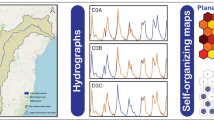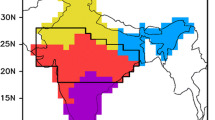Abstract
Hydro-meteorological data is an important asset that can enhance management of water resources. But existing data often contains gaps, leading to uncertainties and so compromising their use. Although many methods exist for infilling data gaps in hydro-meteorological time series, many of these methods require inputs from neighbouring stations, which are often not available, while other methods are computationally demanding. Computing techniques such as artificial intelligence can be used to address this challenge. Self-organizing maps (SOMs), which are a type of artificial neural network, were used for infilling gaps in a hydro-meteorological time series in a Sudano-Sahel catchment. The coefficients of determination obtained were all above 0.75 and 0.65 while the average topographic error was 0.008 and 0.02 for rainfall and river discharge time series, respectively. These results further indicate that SOMs are a robust and efficient method for infilling missing gaps in hydro-meteorological time series.










Similar content being viewed by others
References
Adeloye, A. J., Rustum, R., & Kariyama, I. D. (2012). Neural computing modelling of the reference crop evapotranspiration. Environmental Modelling & Software, 29, 61–63.
ASCE Task Committee on Application of Artificial Neural Networks in Hydrology. (2000). Artificial neural networks in hydrology. II: hydrologic applications. Journal of Hydrologic Engineering, 5(2), 124–137.
Boyer, J., Dieulin, C., Rouche, N., Cres, A., Servat, E., & Paturel, J. (2006). SIEREM: An Environmental Information System for Water Resources (Vol. IAHS Publication 308). Wallingford, United Kingdom: IAHS Press.
Campozano, L., Sanchez, E., Aviles, A., & Samaniego, E. (2014). Evaluation of infilling methods for time series of daily precipitation and temperature: the case of the Ecuadorian Andes. Maskana, 5(1), 99–115.
Candela, L., Elorza, F. J., Tamoh, K., Jiménez-Martínez, J., & Aureli, A. (2014). Groundwater modelling with limited data sets: the Chari–Logone area (lake Chad basin, Chad). Hydrological Processes, 28, 3714–3727.
Coumou, D., & Rahmstorf, S. (2012). A decade of weather extremes. Nature Climate Change, 2, 491–496.
Daniel, E. B., Camp, J. V., LeBoeuf, E. J., Penrod, J. R., Dobbins, J. P., & Abkowitz, M. D. (2011). Watershed modelling and its applications: a state-of-the-art review. The Open Hydrology Journal, 5, 26–50.
Dastorani, M. T., Moghadamnia, A., Piri, J., & Ramirez, M. R. (2010). Application of ANN and ANFIS models for reconstructing missing flow data. Environmental Monitoring and Assessment, 166(1-4), 421–34.
Elshorbagy, A. A., Panu, U. S., & Simonovic, S. P. (2000). Group-based estimation of missing hydrological data: approach and general methodology. Hydrological Sciences Journal, 45(6), 849–866.
Gabrielsson, S., & Gabrielsson, S. (2006). The use of Self-Organizing Maps in Recommender Systems: A survey of the Recommender Systems field and a presentation of a State of the Art Highly Interactive Visual Movie Recommender System (Master Thesis, Uppsala University).
Garcia, H., & Gonzalez, L. (2004). Self-organizing map and clustering for wastewater treatment monitoring. Engineering Applications of Artificial Intelligence, 17(3), 215–225.
Harvey, C. L., Dixon, H., & Hannaford, F. (2012). An appraisal of the performance of data-infilling methods for application to daily mean river flow records in the UK. Hydrology Research, 43(5), 618–636. doi:10.2166/nh.2012.110.
Ismail, S., Shabri, A., & Samsudin, R. A. (2012). Hybrid model of self-organizing maps and least square support vector machine for river flow forecasting. Hydrology and Earth System Sciences, 16, 4417–4433.
Kagoda, P. A., Ndiritu, J., Ntuli, C., & Mwaka, B. (2010). Application of radial basis function neural networks to short-term streamflow forecasting. Physics and Chemistry of the Earth, 35, 571–581.
Kalteh, A. M., & Hjorth, P. (2009). Imputation of missing values in a precipitation–runoff process database. Hydrology Research, 40(4), 420–432.
Kalteh, A. M., Hjorth, P., & Berndtsson, R. (2008). Review of the self-organizing map (SOM) approach in water resources: analysis, modelling and application. Environmental Modelling & Software, 23, 835–845.
Kalteh, A. M., & Berndtsson, R. (2007). Interpolating monthly precipitation by self-organizing map (SOM) and multilayer perceptron (MLP). Hydrological Sciences Journal, 2(2), 305–317.
Kang, H. M., & Yusof, F. (2012). Application of self-organizing map (SOM) in missing daily rainfall data in Malaysia. International Journal of Computer Applications, 48(5), 23–28.
Kashani, M. H., & Dinpashoh, Y. (2012). Evaluation of efficiency of different estimation methods for missing climatological data. Stochastic Environmental Research and Risk Assessment, 26, 59–71.
Kim, M., Baek, S., Ligaray, M., Pyo, J., Park, M., & Cho, K. H. (2015). Comparative studies of different imputation methods for recovering streamflow observation. Water, 7, 6847–6860.
Kingston, G. B., Dandy, G. C. & Maier, H. R. (2008a). Review of artificial intelligence techniques and their applications to hydrological modeling and water resources management Part 2 – optimization. In Robinson, L.N. (ed), Water Resources Research Progress, Chapter 2, Nova, pp. 67–99.
Kingston, G. B., Dandy, G. C., & Maier, H. R. (2008b). AI techniques for hydrological modelling and management Part 1 - simulation. In Robinson, L.N. (ed). Water Resources Research Progress, Chapter 2, Nova, pp. 15-65.
Kohonen, T. Self-Organizing Maps, Springer Series in Information Sciences, vol. 30, Springer, Heidelberg, 1st ed., 1995; 2nd ed., 1997.
Mwale, F. D., Adeloye, A. J., & Rustum, R. (2014). Application of self-organising maps and multi-layer perceptron-artificial neural networks for streamflow and water level forecasting in data-poor catchments: the case of the Lower Shire floodplain, Malawi. Hydrology Research, 45(6), 838–854.
Mwale, F. D., Adeloye, A. J., & Rustum, R. (2012). Infilling of missing rainfall and streamflow data in the shire river basin, Malawi—a self-organizing map approach. Physics and Chemistry of the Earth, 50–52, 34–43.
Ng, W. W., & Panu, U. S. (2010). Infilling missing daily precipitation data at multiple sites using the multivariate truncated normal distribution model for weather generation. Water, 8 pp.
Presti, R. L., Barca, E., & Passarella, G. A. (2010). Methodology for treating missing data applied to daily rainfall data in the Candelaro River Basin (Italy). Environmental Monitoring and Assessment, 160, 1–22.
Rustum, R., & Adeloye, A. J. (2007). Replacing outliers and missing values from activated sludge data using kohonen self-organizing Map. Journal of Environmental Engineering, 133(9), 909–916.
Seeber, K. (2013). Consultation of the Lake Chad Basin Commission on Groundwater Management. Project: Sustainable Management of the Lake Chad Basin, BGR No:05-2355.
Vesanto, J., Himberg, J., Alhoniemi, E., & Parhankangas, J. (2000). SOM Toolbox for Matlab 5 (Report A57). Helsinki, Finland: Helsinki University of Technology.
WWAP (United Nations World Water Assessment Programme). (2015). The United Nations World Water Development Report 2015: Water for a Sustainable World. Paris: UNESCO.
Acknowledgments
This research was supported by a Commonwealth Scholarship award to the first author. We are grateful to SIEREM and the Lake Chad Basin Commission for providing the data used in this research.
Author information
Authors and Affiliations
Corresponding author
Rights and permissions
About this article
Cite this article
Nkiaka, E., Nawaz, N.R. & Lovett, J.C. Using self-organizing maps to infill missing data in hydro-meteorological time series from the Logone catchment, Lake Chad basin. Environ Monit Assess 188, 400 (2016). https://doi.org/10.1007/s10661-016-5385-1
Received:
Accepted:
Published:
DOI: https://doi.org/10.1007/s10661-016-5385-1




